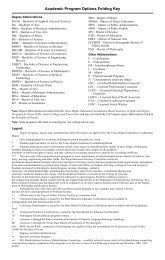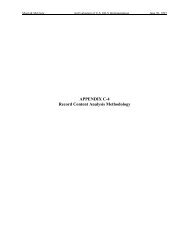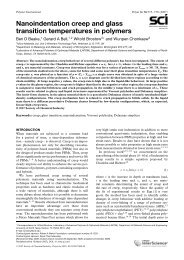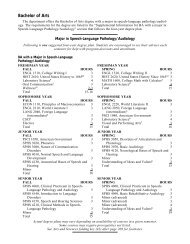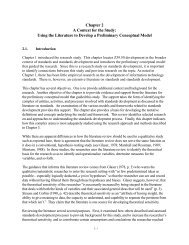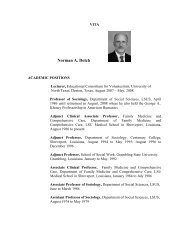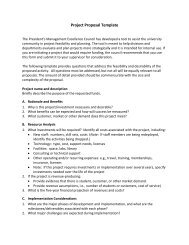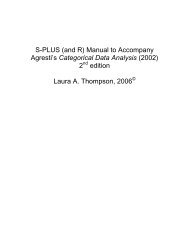600 HOLMBECKthe generative mechanism through which the focal independent variableis able to influence the dependent variable of interest . . .(and) Mediation... is best done in the case of a strong relationbetween the predictor and the criterion variable. (pp. 1173, 1178)Stated more simply, "the independent variable causes the mediatorwhich then causes the outcome" (Shadish & Sweeney, 1991,p. 883). Although one may argue that the relationships amongindependent variable, mediator, and outcome may not necessarilybe "causal," the nature of the mediated relationship is suchthat the independent variable influences the mediator which, inturn, influences the outcome. Also critical is the prerequisitethat there be a significant association between the independentvariable and the dependent variable before testing for a mediatedeffect.Mediators and moderators can also be differentiated diagrammatically(see Figure 1; see also Baron & Kenny, 1986; Cohen &Cohen, 1983). A mediator (B in the top model in Figure 1)falls in the causal pathway between two variables (A and C inthe top model in Figure 1; James & Brett, 1984); that is, ifAis significantly associated with C, and if A influences B and Binfluences C, then B is a mediating variable between A and C(more detailed criteria are discussed later). On the other hand,if A is expected to be related to C, but only under certainconditions of B, then B is a moderator variable (see the bottommodel in Figure 1 ). The moderator (B) can be drawn to indicatethat it has an impact on the relationship between A and C.Although some variables are more likely to be moderators thanmediators (e.g., gender), some variables could serve either function,depending on the conceptual model under investigation(although not in the same analysis; see Lewis & Kliewer, 1996;Quittner, Glueckauf & Jackson, 1990; Sandier, Tein, & West,1994, for examples where coping strategies or social supportwere tested as both mediators and moderators in competingmodels). Moreover, both moderators and mediators can be specifiedwithin the same model (e.g., moderated mediation;James & Brett, 1984; for examples of this strategy, see Harnish,Dodge, & Valente, 1995; <strong>Holmbeck</strong>, 1996; Simons, Lorenz,Wu, & Conger, 1993).An example illustrates the distinction between moderated andAfB' CA ,CTBFigure 1. Models of mediated and moderated effects. In the top model,B mediates the relationship between A and C. In the bottom model, Bmoderates the relationship between A and C.mediated effects. This example is based on Fauber, Forehand,Thomas, and Wierson's (1990) study of marital conflict andadolescent adjustment in intact and divorced families. To examinethe processes by which marital conflict has a negative influenceon child adjustment, Fauber and his colleagues hypothesizedthat marital conflict has a negative impact on the qualityof parenting to which a child is exposed which, in turn, has animpact on child adjustment. In this case, parenting quality is apotential mediator of the conflict --* adjustment relationship andis predicted to account (at least partially) for this relationship.Alternatively, if one sought to test the hypothesis that the conflict--* adjustment relationship would hold only for divorced familiesand would not hold for intact families, then one would be studyingwhether family structure (i.e., intact vs. divorced) moderatesassociations between marital conflict and child adjustment.Statistical Strategies for Testing Moderated EffectsFor both moderated and mediated effects, two types of statisticalstrategies are discussed: multiple regression (as reviewedby Baron & Kenny, 1986, and as used by several investigators)and structural equation modeling (SEM; see Tabachnick & Fidell,1996, for a relatively straightforward discussion; also seeBollen, 1989; Byrne, 1994; Hoyle, 1995; Jaccard & Wan, 1996;Mueller, 1996). Although SEM is often considered the preferredmethod because of the information that it provides on the degreeof "fit" for the entire model after cbntrolling for measurementerror (Peyrot, 1996), proper use of regression techniques canalso provide meaningful tests of hypotheses. Moreover, for investigatorsworking in the area of pediatric psychology, wheresample Ns are often relatively small, use of regression techniques(as opposed to SEM) may be necessary because of powerconsiderations (see Tabachnick & Fidell, 1996, for a discussionof sample size and SEM). Although regression strategies maybe more familiar to many readers of this journal, user-friendlyversions of SEM software are now available (e.g., EQS; Bentler,1995; although Jaccard & Wan, 1996, argue that LISREL 8,Jtreskog & StJrbom, 1993, is currently the preferred softwarewhen attempting to analyze the significance of interaction effectsbecause EQS does not permit nonlinear constraints amongparameters).Regression Approach to Testing Moderated EffectsAlthough the manner in which moderators are tested statisticallyvaries somewhat depending on whether the predictor andmoderator are continuous or dichotomous (Baron & Kenny,1986; Mason, Tu, & Cauce, 1996), the general strategy is thesame regardless of the nature of the variables involved. As notedearlier, a moderator effect is an interaction effect. The preferredstrategy is to use the variables in their continuous form (if theyare not dichotomies) and to use multiple regression techniques(Cohen & Cohen, 1983; Cohen & Wills, 1985; Jaccard, Turrisi,& Wan, 1990; James & Brett, 1984; Mason et al., 1996).The predictor and moderator main effects (and any covariates,if applicable) are entered into the regression equation first, followedby the interaction of the predictor and the moderator (e.g.,Fuhrman & <strong>Holmbeck</strong>, 1995). Depending on the investigator'sconceptual framework, the main effects can be entered in ahierarchical, stepwise, or simultaneous fashion (Cohen & Co-
MEDIATORS AND MODERATORS 601hen, 1983). For example, in analyses involving marital conflictas a predictor and family structure as a moderator, marital conflictand family structure could be entered in any order or simultaneously.The interaction term is represented by the product ofthe two main effects (e.g., Marital Conflict × Family Structure)and "only becomes the interaction when its constituent elementsare partialled" (Cohen & Cohen, 1983, p. 305; see also Aiken &West, 1991; Evans, 1991; Friedrich, 1982; <strong>Holmbeck</strong>, 1989).Thus, although the main effects may be entered in any order,they must be entered before the interaction term for the productof these two terms to represent the interaction when it entersthe equation.Given the manner in which the interaction is computed, themain effects (i.e., the predictor and the moderator) will behighly correlated with the interaction term, which can produce"ill-conditioning" error messages when using some statisticalsoftware packages. To eliminate problematic multicollinearityeffects between first-order terms (i.e., the independent variableand the moderator) and the higher order terms (i.e., the interactionterms), Aiken and West ( 1991 ) have recommended that theindependent variable and the moderator be "centered" beforetesting the significance of the interaction term. To center a variable,scores are put into deviation score form by simply subtractingthe sample mean from all individuals' scores on thevariable, thus producing a revised sample mean of zero. Suchtransformations have no impact on the level of significance ofthe interaction terms or the simple slopes of any plotted regressionlines.Statistically significant interactions are interpreted by plottingsimple regression lines for high and low values of the moderatorvariable (Aiken & West, 1991; Cohen & Cohen, 1983; James &Brett, 1984; for recent examples with data tables or figures, seeBrody, Stoneman, & Gauger, 1996; Colder, Lochman, & Wells,in press; Fuhrman & <strong>Holmbeck</strong>, 1995; Silverberg, Marczak, &Gondoli, 1996; Wagner, Cohen, & Brook, 1996). To plot regressionlines, an equation is used that includes terms for the covariates(if applicable), the two main effects (e.g., marital conflictand family structure), and the interaction term (e.g., MaritalConflict x Family Structure), along with the correspondingunstandardized regression coefficients and the y intercept (Aiken& West, 1991; Cohen & Cohen, 1983; <strong>Holmbeck</strong>, 1989).By substituting into this equation all possible combinations ofhigh (e.g., M + 1 SD) and low (e.g., M - 1 SD) values of thepredictor and the moderator (i.e., high-high, low-low, high-low,and low-high), two regression lines can be generated wherepredicted values of the dependent variable are plotted (e.g.,Fuhrman & <strong>Holmbeck</strong>, 1995). Also, as carefully explained byAiken and West (1991), investigators can test the significanceof the slopes for these simple regression lines (e.g., Colder,Lochman, & Wells, in press; Silverberg et al., 1996; Wagner etal., 1996; although, in some cases, associations between thepredictor and the dependent variable may be curvilinear; Molina& Chassin, 1996). In the case of categorical moderatorvariables, high and low values are represented by the two dichotomousdummy values for this variable. With respect to covariates,the means can be substituted for these terms in the equation(which are multiplied by their corresponding regressionweights). This strategy for including covariates should only beused, however, if the investigator has tested for the presence ofsignificant interaction effects between the covariates and independentvariables and found them to be nonsignificant.As a caution to the reader, it is worth noting that significantmoderator effects may be difficult to detect statistically. Thisdifficulty is most likely to occur in studies where samples arerelatively homogeneous because all high and low values of themoderator and predictor may not be adequately represented (seeMcClelland & Judd, 1993, for a complete discussion of thisissue). Also, unreliability of measurement in the main effectsis compounded once a multiplicative term is computed (seeJaccard & Wan, 1995, for suggestions on how to examine andtake into account such unreliability when conducting statisticalanalyses).SEM Approach to Testing Moderated EffectsBecause of the problem of compounding of measurementerror when computing interaction terms, several authors havemaintained that SEM strategies provide a less biased assessmentof the significance of moderator effects (e.g., Jaccard & Wan,1996; Peyrot, 1996; Ping, 1996). In fact, regression strategiestend to underestimate the effect size of the interaction term,particularly as measurement error in the predictor and moderatorvariable increases (Jaccard & Wan, 1996; Peyrot, 1996). TheSEM strategy is also preferred when the investigator has morethan one measured variable for each of the constructs (or latentvariables) assessed.The logic behind testing the significance of interaction effectswith SEM designs is relatively straightforward, particularlywhen the moderator is a dichotomous variable (Jaccard & Wan,1996; Ping, 1996). Suppose that one is interested in whetherthe association between a latent predictor variable (which isassessed with more than one measured variable) and a latentcriterion variable (which is also assessed with more than onemeasured variable) vary as a function of gender. To test for thepresence of moderation, one assesses the overall fit of the modelunder two conditions: (a) when there are no constraints on thesolution (i.e., when the relationship between the predictor andcriterion variables can vary as a function of gender) and (b)when the association between the predictor and criterion variablesis constrained to be equal (i.e., an equality constraint) forthe two genders (see Farrell, 1994; Jaccard & Wan, 1996, formore in-depth treatments of this data-analytic technique; seeSimons et al., 1993, for an empirical example). The effect ofthis constraint is to test a model where no Predictor x Genderinteraction is present. One can then calculate and test the significanceof the difference between the goodness-of-fit chisquarevalues for the two models. Unlike other data-analyticstrategies, nonsignificant (i.e., lower) chi-square values are indicativeof a better fit. The magnitude of the difference betweenchi-square values determines the degree to which an interactioneffect is present; that is, if there is a significant deterioration inmodel fit when evaluating the model under the constraint of thesecond condition (an assumption of no interaction), this wouldindicate that a significant interaction is present.When the predictor, criterion, and moderator are all continuous,the analyses are more complex. On initial inspection, one mayassume that all possible products of the measured indicators couldbe computed as indicators of a latent interaction variable (e.g.,there would be 25 such interaction indicators if the moderator




